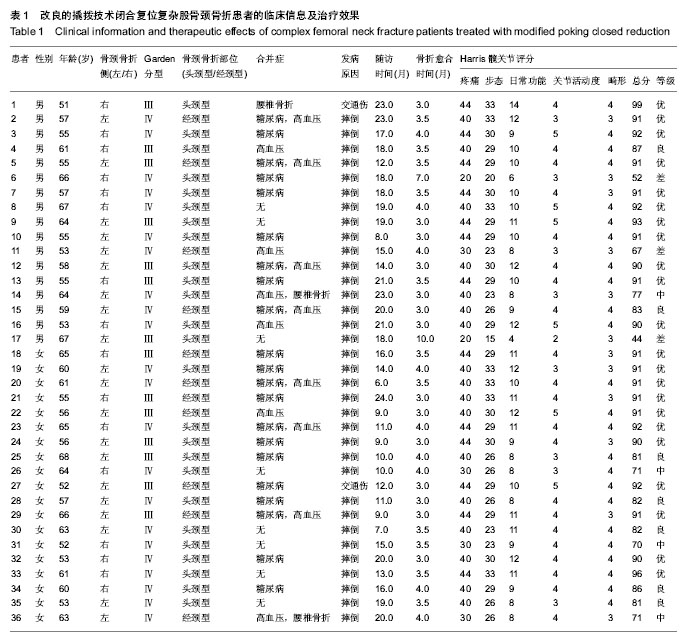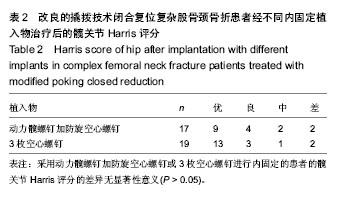| [1] Basso T, Klaksvik J, Syversen U, et al. Biomechanical femoral neck fracture experiments--a narrative review. Injury. 2012; 43(10):1633-1639.
[2] Souder CD, Brennan ML, Brennan KL, et al. The rate of contralateral proximal femoral fracture following closed reduction and percutaneous pinning compared with arthroplasty for the treatment of femoral neck fractures. J Bone Joint Surg Am. 2012;94(5):418-425.
[3] 陈跃平,高辉,陈亮,等.关节置换与植入物内固定治疗老年移位型股骨颈骨折的系统评价[J].中国组织工程研究,2012,16(9): 148-152.
[4] Støen RØ, Lofthus CM, Nordsletten L, et al. Randomized trial of hemiarthroplasty versus internal fixation for femoral neck fractures: no differences at 6 years. Clin Orthop Relat Res. 2014;472(1):360-367.
[5] von Friesendorff M, Besjakov J, Akesson K. Long-term survival and fracture risk after hip fracture: a 22-year follow-up in women. J Bone Miner Res. 2008;23(11):1832-1841.
[6] Gao H, Liu Z, Xing D, et al. Which is the best alternative for displaced femoral neck fractures in the elderly?: A meta-analysis. Clin Orthop Relat Res. 2012;470(6):1782- 1791.
[7] 艾自胜,张长青,刘粤,等.股骨颈骨折内固定术后随访资料的Harris评分分析[J].中国修复重建外科杂志,2009,23(4):57-61.
[8] Zuckerman JD. Hip fracture. N Engl J Med. 1996;334(23): 1519-1525.
[9] 李海峰,亓玉彬,李强,等.老年人股骨颈骨折手术治疗进展[J].中国老年学杂志,2013,33(3):231-233.
[10] 何振辉.股骨颈骨折经皮撬拨复位法[J].中国中医骨伤科, 1993, (3):39-41.
[11] 侯喜君,李霖,王春华,等.陶瓷对陶瓷全髋关节置换治疗中青年股骨颈骨折的分析[J].中国组织工程研究,2013,17(52):8955-8960.
[12] Karanicolas PJ, Bhandari M, Walter SD, et al. Interobserver reliability of classification systems to rate the quality of femoral neck fracture reduction. J Orthop Trauma. 2009; 23(6):408-412.
[13] Harris WH. Traumatic arthritis of the hip after dislocation and acetabular fractures: treatment by mold arthroplasty. An end-result study using a new method of result evaluation. J Bone Joint Surg Am. 1969;51(4):737-755.
[14] Murphy DK, Randell T, Brennan KL, et al. Treatment and displacement affect the reoperation rate for femoral neck fracture. Clin Orthop Relat Res. 2013;471(8):2691-2702.
[15] 韦利红,徐良丰,单军标.克氏针撬拨辅助复位空心钉内固定治疗股骨颈骨折[J].中医正骨,2013,25(1):53-54.
[16] 倪增良,樊渊,唐海军,等.撬拨复位空心钉内固定治疗股骨颈骨折[J].中国骨伤,2009,22(9):70-71.
[17] Su Y, Chen W, Zhang Q, et al. An irreducible variant of femoral neck fracture: a minimally traumatic reduction technique. Injury. 2011;42(2):140-145.
[18] 刘明武.双针撬拨辅助复位加空心钉内固定治疗股骨颈骨折[J].湖北中医杂志,2011,33(7):75.
[19] 孙彦豹,王静,金宝城,等.闭合复位动力髋螺钉联合防旋螺钉内固定治疗PauwelsIII型股骨颈骨折[J].创伤外科杂志,2013,15(6): 513-515. |


